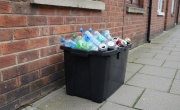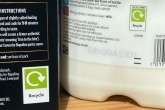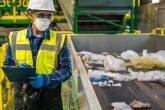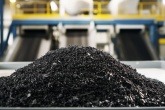EU harmonised waste sorting labels face design challenges
European Commission researchers seek balance between simplicity and precision for EU-wide packaging labelling system that must accommodate diverse national waste collection practices.

The consultation, which gathered input from over 300 stakeholders across the waste management and packaging sectors, forms part of the technical groundwork for implementing the EU Packaging and Packaging Waste Regulation (PPWR) that entered into force last month (February 2025).
According to the JRC, the consultation aims ‘to gather feedback on design considerations of harmonised material-based waste sorting labels applied to packaging and waste receptacles in the European Union.’ These labels will establish visual correspondence between packaging and bins to enable consumers to correctly dispose of packaging waste.
The findings highlight competing priorities among different stakeholder groups, with packaging producers generally favouring simpler systems with fewer distinct labels while waste management operators tend to prefer more granular labelling that assist more accurate sorting.
System design reveals tensions about level of detail
A key area of contention is the granularity of material categories, i.e. deciding how many packaging materials require their own separate labels. The first prototype presented in the consultation included 11 distinct materials across 8 material categories, but stakeholder feedback revealed significant disagreement about which materials should be grouped together.
The prototype's separation of hard and soft plastics drew particular criticism, with 38.7 per cent of respondents preferring a single plastic label compared to just 18.4 per cent supporting separate labels. Similarly, while the prototype showed distinct labels for paper and cardboard, 47.9 per cent of respondents favoured combining them under a single label.
"Stakeholders frequently highlighted that the granularity should be as simple as possible and as complex as necessary," the report noted, identifying the need to balance simplicity for consumers with sufficient detail for accurate sorting.
Composite materials and bioplastics emerged as particularly challenging materials for labelling. For fibre-based composite packaging such as drink cartons, 36.8 per cent of stakeholders supported separate labels, while 22.1 per cent preferred including them under broader material categories.
The report also highlighted varying national practices in waste collection that complicate label harmonisation. For instance, paper and cardboard are "frequently commingled, although some Nordic countries nowadays collect them separately," while glass collection sometimes involves separate bins for different colours and sometimes doesn't.
These variations create challenges for a system that must work consistently across all EU member states despite their differing waste infrastructure. The report acknowledged that "waste destinations, including the number of receptacles, and rules and practices regarding the commingling and separation of waste materials, differ between and within countries."
Visual design reveals clear stakeholder divisions
Perhaps the most striking division appeared in preferences for visual design elements, particularly regarding the use of colour.
For packaging labels, 38.7 per cent of respondents favoured black and white versions while 28.2 per cent preferred coloured labels. This preference for monochrome packaging labels was largely driven by concerns about increased production costs, environmental impacts of colored printing, potential conflicts with brand designs, and technical printing limitations on certain packaging materials.
However, for waste receptacle labels, the preference reversed dramatically, with 41.1 per cent supporting coloured labels and only 16 per cent preferring black and white. Stakeholders argued that colored receptacle labels enhance visibility and recognition, improve harmonisation with packaging labels, and ultimately lead to better waste sorting outcomes.
Similar divisions emerged regarding text use. For packaging labels, 36.8 per cent opposed including text describing materials while 31.9 per cent supported it. This opposition to text on packaging stemmed primarily from concerns about creating barriers to the EU single market, as text would require translation into multiple languages for cross-border trade. Stakeholders also cited space constraints on packaging, additional production costs, and the view that pictograms alone could suffice for consumer understanding.
For receptacle labels, however, 55.8 per cent favoured text inclusion, with only 12.9 per cent opposed. This stronger support reflects the fact that receptacles remain in one location and language region, eliminating cross-border concerns. Consultation respondents argued that text on receptacles enhances local consumer understanding and education, provides important clarification, and increases the effectiveness of waste sorting.
When text is included, 26.4 per cent preferred national language for packaging, while 44.2 per cent supported national language for receptacles, again reflecting the local nature of waste receptacles versus the cross-border movement of packaged products.
The consultation also explored digital solutions, with 31.9 per cent of respondents supporting QR codes or other digital data carriers on packaging. However, concerns were raised about "accessibility challenges, as certain demographics (e.g., older adults or digitally vulnerable groups) might struggle to use them."
For multi-component packaging containing different materials, 52.1 per cent of stakeholders supported labels identifying the different packaging components, with 25.8 per cent favouring illustrations as the most effective way to indicate which labels apply to which components.
Implementation challenges highlighted
The report identified numerous practical hurdles for both packaging producers and waste management facilities implementing the new labelling system.
For packaging producers, space limitations emerged as a significant concern, "making it difficult to accommodate additional labels, especially on small-sized packaging." Financial costs associated with changing production processes and potential conflicts with branding were also highlighted.
For waste management facilities, the consultation pointed to issues with "standardisation and harmonisation" given the "lack of a harmonised approach to bin colours and collection streams." Durability of receptacle labels exposed to environmental conditions also emerged as a key concern.
Crucially, the report acknowledged the risk of mismatches between the colours used in the harmonised labels and those traditionally associated with specific waste materials in different countries. This could lead to situations where, for example, "a yellow plastic label on a blue plastic bin" might create temporary confusion.
The report stated that stakeholders expect "updates are necessary and should be managed by the European Commission," but stressed that these "should be rare and well-justified" to maintain stability and avoid consumer confusion.
The need for harmonised labels to increase participation in packaging recycling across the EU was highlighted in the Setting the Scene report, released in December 2024, which found that 84.3 million tonnes of packaging waste was generated in 2021.
The development of harmonised waste sorting labels also raises questions about alignment with non-EU countries. In the UK, Defra had initially planned to introduce mandatory recycling labels on packaging by 2026, using the "Recycle Now" mark. However, it has since postponed these requirements, with sources suggesting this is to enable flexibility to reflect the resulting EU position to minimise disruption for businesses trading across both markets.
Timeline for implementation
According to the regulation, the Commission has 18 months from its entry into force to adopt implementing acts on waste sorting labels, setting a deadline of August 2026 for the finalised system.
The JRC report indicates that further evidence-gathering activities are planned, including consumer workshops in six member states and behavioural experiments with approximately 8,800 citizens in 11 member states during the first half of 2025.
A second stakeholder consultation is planned for May 2025, with the feedback helping to refine the second prototype before the final technical proposal is submitted.
The consultation forms part of preparations for implementing the PPWR, which carries forward the packaging waste recycling targets set in Directive (EU) 2018/852, which require 65 per cent of packaging waste by weight to be recycled by the end of 2025, rising to 70 per cent by 2030. It is hoped that harmonised waste sorting labels will provide consistent guidance for consumers across all EU countries, helping member states achieve these targets despite their varying waste collection systems.








